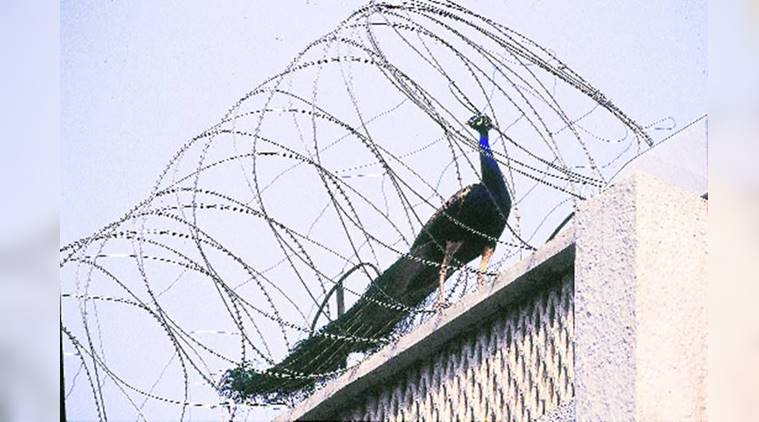Down in Jungleland: Singing in the Rain
Of peacocks and peahens who come alive during the monsoon. It is during the monsoons, that the gentlemen come into their own. A dancing peacock can stop you in your tracks no matter how many times you may have seen it perform before.
 Living with peacocks as your neighbours can be flattering and exasperating.
Living with peacocks as your neighbours can be flattering and exasperating.
They strut around haughtily nearly everywhere in the country: in jungles, parks, golf courses, fields, down kachcha tracks just in front of your car’s bumper (refusing to get out of the way) and, just yesterday, sneaking thief-like into the garden to check out how the torai were doing (Peafowl are omnivorous.).
Living with peacocks as your neighbours can be flattering and exasperating. The ones in my neighbourhood live in the historic Nicholson cemetery that abuts my bedroom. Peacocks have a reputation for being watchdogs par excellence. In the jungles, they are the first to signal the presence and progress of a predator with manic “may-yew!” screams (they have exceptional sight and hearing). So, when the whole bunch of them begins caterwauling together at 3 am from the tops of the tamarind and neem trees in the cemetery, it makes you wonder. Are they informing you of ghosts and zombies returning from a late night out after rattling their vertebrae at the Shakin’ Bones nightclub — and need to be grounded? Or have they sensed sinister presences in the cemetery?
They really are very security conscious. If caught out in the open, they’ll first walk away nonchalantly. If you press closer, they will duck their heads and scuttle away like soldiers under fire — making use of every dip and gradient in the ground to take cover. If they have a panic attack, they will simply take off — vertically — with a great bluster of wings honking dismally, their huge heavy trains no impediment (like Superman’s cloak, I suppose); and then fly away with their trains streaming behind them. But it’s fun to watch them fly down from, say, the terrace of a building or the top of a palm tree. They’ll flap their wings frantically, careen like a lorry without brakes going downhill, honking a warning to all that they have neither direction nor airspeed under control and cannot be responsible for where (or on who) they crash into!
Actually, they don’t really need to fly to get out of the way or into safe cover. It is truly uncanny how even the males, with their cumbersome trains, just vanish amidst the foliage: take your eyes off them for an instant, and pouf! They’ve disappeared!
It is, of course, now, during the monsoons, that the gentlemen come into their own. A dancing peacock can stop you in your tracks no matter how many times you may have seen it perform before. One rainy day, I watched a fellow dance virtually non-stop in the cemetery from 9 am to 7 pm — more than a full working day. His stage was the top of a covered well. His audience: a covey of four or five ladies, who grubbed around him, ostensibly not impressed one bit. But, slyly, they were all obviously checking him out. Not just that! When one of the girls finally gave in and flew up to the well to get cozy, she was indignantly chased away by the alpha hen of the group.
The gentlemen duel, too, when the possession of a harem comes into question. I watched one duel in the cemetery and it was exactly like noblemen of yore dueling at dawn for the hand of a lady. The birds faced each other, framed by monsoon green. Challenging insults rent the air. Then they flew at each other, claws extended, missing each other by a considerable distance. They landed, swung around, their burnished cloaks swishing impressively and repeated the action. Right through the duel, they never once actually established contact. Eventually, one of them just got bored or tired and went off, chased by the victor screaming imprecations.
For birds so wary, they seem to be pretty cavalier about where they make their nurseries. City peacocks especially have been known to lay their eggs on the terraces, porches and verandahs of houses. One peahen deposited an egg on the ground just outside the canteen of Teen Murti House in Delhi — if that’s not tempting fate I don’t know what is. However, once hatched, peahens do protect their babies. Of course, the peacock, being the national bird, is protected by law. So it’s a bit puzzling when you see peacock feathers, perfectly arranged in “fans”, being sold at traffic lights. Yes, the birds shed after the breeding season, so dropped feathers can be picked up. But they don’t drop their entire trains in one place at one go, which is what those perfect fans seem to indicate.
Bird names can often cause confusion. A critic once called a tailorbird in one of my books as a “tailoress bird” because the character was female. There is no such bird as a tailoress bird, but there is a bird called the waterhen — where both lady and gentleman are waterhens. The gent is not a watercock — because that alas is an entirely different species! The peafowl, thankfully, has it well sorted out: the gentleman is the peacock and the lady the peahen.



- 01
- 02
- 03
- 04
- 05




























